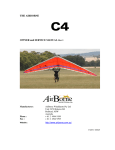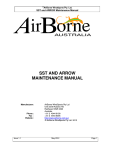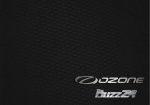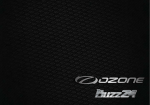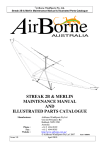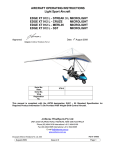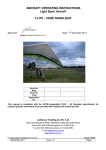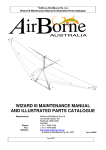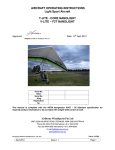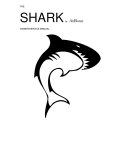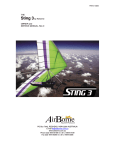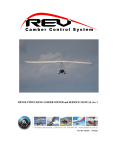Download THE Fun 2 by Airborne OWNER and SERVICE MANUAL Part
Transcript
THE Fun 2 by Airborne OWNER and SERVICE MANUAL Part # 110962 A4-8439 AirBorne WindSports- F2 Manual AIRBORNE DIRECTIVES AS THE SERVICE HISTORY OF THE AIRFRAME EVOLVES AIRBORNE WILL FROM TIME TO TIME ISSUE AIRBORNE DIRECTIVES, WHICH DETAIL ANY CHANGES TO THE MAINTENANCE MANUALS, PILOT’S OPERATING HANDBOOK, OR ANY OTHER DETAILS THAT AIRBORNE DEEMS NECESSARY FOR OWNERS TO BE NOTIFIED OF. THE WEB ADDRESS FOR AIRBORNE DIRECTIVES IS: HTTP://WWW.AIRBORNE.COM.AU/ WARNING THE INFORMATION IN THIS MANUAL NEEDS TO BE FOLLOWED, AND IT IS NOT ACCEPTABLE TO MAKE CHANGES TO THE MATERIALS AND OR PHYSICAL FEATURES OF THIS AIRCRAFT. IN PARTICULAR THE GRADES OF BOLTS THAT HAVE BEEN UTILISED IN THE MANUFACTURE OF THIS AIRCRAFT ARE CRITICAL FOR ITS CONTINUING AIRWORTHINESS. NEVER REPLACE BOLTS WITH ANY OTHER SIZE OR GRADE. GRADE 8 BOLTS ARE NOT INTERCHANGEABLE WITH AIRCRAFT (AN) GRADE BOLTS. THE FATIGUE CHARACTERISTICS OF AIRCRAFT GRADE BOLTS ARE SUPERIOR TO OTHER BOLTS AND ALLOW LONGER SAFE SERVICE LIFE UNDER CYCLIC LOADS LIKE THOSE EXPERIENCED IN AIRCRAFT. THE LENGTH OF THE BOLT IS IMPORTANT. IF A SHORTER BOLT IS USED THE THREAD MAY ENCROACH ON THE LOAD BEARING AREA, WHICH INCREASES THE STRESSES EXPERIENCED BY IT. Issue Date: 1 March 2012 Page 2 AirborneWindSports-F2 Manual MANUAL REVISION HISTORY Revision No 0 Description Initial Issue Applicable Serial No FN-190-001> FN-190-001U> Date 1 March 2012 Table 1 Revision History Issue Date: 1 March 2012 Page 3 AirBorne WindSports- F2 Manual TABLE OF CONTENTS MANUAL REVISION HISTORY ................................................................................................3 TABLE OF CONTENTS............................................................................................................4 Section 1 DESIGN FEATURES..........................................................................................5 Section 2 SPECIFICATIONS..............................................................................................6 Section 3 OPERATING LIMITATIONS...............................................................................7 Section 4 WARRANTY STATEMENT ................................................................................8 Section 5 WING ASSEMBLY PROCEDURE..............................................................9 Section 6 PRE-FLIGHT INSPECTION .............................................................................14 Section 7 BREAK DOWN PROCEDURE .........................................................................15 Section 8 ASSEMBLY FROM SHIPPING LENGTH.........................................................16 Section 9 FLIGHT TECHNIQUE.......................................................................................18 Section 10 TUNING............................................................................................................19 Section 11 PERIODIC INSPECTIONS and MAINTENANCE.............................................24 Section 12 TRANSPORTATION AND STORAGE .............................................................28 Section 13 MAINTENANCE RECORD...............................................................................29 Section 14 HANG GLIDER COMPLIANCE SCHEDULES .................................................30 F2 190 ....................................................................................................................................... 30 Issue Date: 1 March 2012 Page 4 AirborneWindSports-F2 Manual Section 1 DESIGN FEATURES The F2 is a refinement of the Fun which is the most successful entry-level glider ever produced in Australia. The F2 still retains all of the good features of the original Fun whilst being the lightest in its class. Although the glider is very similar to look at, the F2 has the following improvements: SAIL The Sail has been reworked to include a new luff curve which pre loads the leading edge and enhances performance. The other significant advantage is the increase in trailing edge tension therefore eliminating flutter at normal operating speeds. The panel layout is “rim and fill” style like the Rev which allows coloured main sail with reinforcing cloth around the higher loaded “rim” area A lightweight nose cone has been added which improves the overall look of the glider The leading edge incorporates a leading edge pocket, which improves airfoil definition and allows fitment of optional mylar inserts Batten pockets have been modified to accept hinge fittings giving a high performance trailing edge. Many other minor changes have been made to the sail to achieve the final result. This includes improved sink rate, reduced pitch pressure and improved glide performance whilst retaining the Fun handling. FRAME The frame has some changes including new cross bar leading edge hardware to allow for better sail fit at the junction. A new round down tube knuckle has been developed to allow fitment of optional speed bars such as Round and Faired as available on the Sting 3 and Rev. An optional faired control frame is available. Hinged Battens are now standard on the F2. A curved tip strut has been added which is located in the sail pocket rather than a hook on the leading edge. The main advantage is the ease of installation especially in windy conditions. The reflex bridle attachment has been moved forward, which improves pitch stability and improves ground handling. OPTIONS The F2 has the following options available: Faired Control Frame Alternative Round Speed Bar and Faired Speed Mylar leading edge inserts A 3rd sail colour option is also available as an option At AirBorne we have a well-developed quality assurance program, ensuring that every glider is built in accordance with the standard it was designed and tested to. This gives even the most experienced pilot a sense of security. We hope that you have hours of great flying with your new glider. Fly high and safely. Team AirBorne Issue Date: 1 March 2012 Page 5 AirBorne WindSports- F2 Manual Section 2 SPECIFICATIONS STANDARD SPECIFICATIONS F2 190 METRIC IMPERIAL SAIL AREA 17.7 sq meter 190 sq ft WING SPAN 10.1 m 33.1 feet ASPECT RATIO 5.8 NOSE ANGLE 118 degrees DOUBLE SURFACE % 30 % BATTENS GLIDER WEIGHT 15 23 kg ASSEMBLY TIME 51 pound 6 min PACK UP LENGTH 5.9 meter 19.5 feet SHORT PACK LENGTH 4.1 meter 13.4 feet RECOMMENDED PILOT HOOK IN WEIGHT RANGE (Includes Equipment) 70-120 kg 154-265 pounds VNE (Velocity Never to Exceed) 80 km/h 50 mph VA (Maximum rough air manoeuvring speed) 69 km/h 43 mph Note The stall speed for of the F2 at maximum recommended wing loading is 25 mph (40 km/h) or less. The maximum, or steady state speed is at least 35 mph (56 km/h) for a prone pilot with correctly adjusted harness. Conversions: * 0.4536 kg/pound * 25.4 mm/inch * 1.609 km/mile • Va = Test speed x 0.707 * Vne = Test Speed x 0.816 Issue Date: 1 March 2012 Page 6 AirborneWindSports-F2 Manual Section 3 OPERATING LIMITATIONS WARNING Hang Gliding is a high risk sport. The safe operation of this hang glider ultimately rests with you, the pilot. We believe that in order to fly safely you must maturely practice the sport of hang gliding. You should never fly this hang glider beyond the placarded limits. The velocity never to exceed (VNE) for your glider is given in Section 2, as is the maximum speed for manoeuvres or flying in rough air (VA). The indicated airspeeds given are for calibrated instruments mounted on, or near, the base bar of the control frame. During your initial flights on the glider it is recommended that you fly with an airspeed indicator until you are able to recognise the control feel that produces the airspeeds shown. Flight operations should be limited to non-aerobatic manoeuvres where the pitch angle does not exceed 30 degrees up or down to the horizon and where the bank angle does not exceed 60 degrees. Aggressive stalls and spins should not be attempted. Operations outside the recommended flight envelope, such as aerobatic manoeuvres or erratic pilot technique may ultimately produce equipment failure. Your glider was designed for foot launched soaring and should not be flown by more than one person at a time. It should not be flown backwards or inverted. The setting up and breaking down of a hang glider, transportation on cars and flying itself, will have an effect over time on its structural integrity. The glider will require maintenance as outlined in the maintenance section of this manual. Like any aircraft safety depends on a combination of careful maintenance and your ability to fly intelligently and conservatively. The owner and operator must understand that due to inherent risks involved in flying a hang glider, no warranty of any kind is made or implied against accidents, bodily injury and death, other than those which cannot by law be excluded. We hope that your new glider will provide you with many hours of safe flying. AIRBORNE. Issue Date: 1 March 2012 Page 7 AirBorne WindSports- F2 Manual Section 4 WARRANTY STATEMENT This warranty extends to new Hang Gliders and/or accessories and equipment manufactured by AIRBORNE WINDSPORTS PTY LTD (“Airborne”) and shall not embrace any other accessories or equipment in the sale. AIRBORNE warrants to the customer the hang glider and/or accessories manufactured or supplied by AIRBORNE to be free from defect in material and workmanship under normal use and service and of merchantable quality and fit the purpose for which they are ordinarily used. This Warranty will apply for a period of ninety (90) days from the date of dispatch of the hang glider not withstanding the number of hours flown but subject to the hang glider remaining the property of the customer. This warranty does not exclude any rights implied in favour of any customer by any applicable Federal and State legislation. AIRBORNE will make good any parts required because of defective material or workmanship as set out in the Warranty. THE WARRANTY WILL NOT APPLY TO: • Any mechanical adjustments, parts, replacements, repairs or other servicing that in the judgement of AIRBORNE are made or should be made as maintenance. • Any defect caused by any alteration or modification not approved by AIRBORNE. • Any defect caused by the fitment of parts that are not made or approved by AIRBORNE. • Any defect caused by misuse, accidents, negligence or failure to carry out proper maintenance service. • Damage caused by continued operation of the hang glider after it is known to be defective. • Any defect or consequential loss, damage or injury caused by overloading. • Loss of use of the hang glider, loss of time, inconvenience, damages for personal injuries, loss of property or other consequential damages. • Failure due to wear and tear, accident, fire, incorrect or incomplete rigging and/or assembly, exposure to the elements, operation outside the placarded limitations and repairs attempted or made other than by AIRBORNE or its authorised agent. AIRBORNE will replace, free of charge, any original part that is determined by AIRBORNE to be defective under the terms of this Warranty and reserves the right to pay monetary compensation or make good the defect in any manner it deems appropriate. he customer is responsible for transporting the hang glider or parts to and from AIRBORNE or its authorised agent when making claims under this Warranty. The hang glider or parts are at the customer’s risk whilst in transit to and from AIRBORNE or its authorised agent. NOTE: Warranty service is available to the customer from AIRBORNE WINDSPORTS PTY LIMITED or authorised agent. AIRBORNE WINDSPORTS Issue Date: 1 March 2012 Page 8 AirborneWindSports-F2 Manual Section 5 WING ASSEMBLY PROCEDURE The wing can be assembled in two positions, either lying flat or standing on the control frame. Assembling the F2 on the control frame is the most popular method of assembly in light winds. This method is preferable as the sail is less prone to being soiled or damaged during assembly. In higher winds it is preferable to lay the glider flat for assembly with the nose into the wind until ready to launch. The following instructions apply to the F2 wing. This sequence of procedures assumes that the wing is packed up. Your instructor or dealer should demonstrate the correct assembly and disassembly procedures. This section is intended as a reference only and assumes prior knowledge of assembly. The suggested assembly procedure is as follows: Unzip Wing Bag Lay the wing down with the zip up and the nose facing approximately 120 degrees from the wind direction. Unzip the bag but do not completely remove it from the wing. Undo centre 2 clips. Figure 1 Section 5. Unzip wing bag Assemble Control Frame Remove control bar and down tube padding. Spread the control bar down tubes out and insert the base bar onto the alloy knuckles. The pip pins are then inserted from front to back. Ensure they are secured. It should not be possible to remove a cap without depressing the pip pin button. Check that all the rigging wires are outside the control frame. Figure 2 Section 5. Assemble control frame Issue Date: 1 March 2012 Page 9 AirBorne WindSports- F2 Manual Stand The Wing Up Rotate the control frame to the vertical position so that the wing is resting on the control bar. Connect the nose catch. The glider bag can be removed. Unclip all the wing straps. The nose batten can be inserted now or later after the tension has been pulled on the wing. It’s easiest to do so now. Figure 3 Section 5. Stand the wing up Spread Leading Edges Carefully spread both leading edges out half way then spread them both out to the approximate flying position. It is essential that the keel and the leading edges are kept in the same plane or damage will result. Each wing should be kept low to the ground whilst moving forward. Figure 4 Section 4. Spreading the leading edges Issue Date: 1 March 2012 Page 10 AirborneWindSports-F2 Manual Raise King Post And Connect Reflex Bridle Stand king post up from its lying position. Check that wires aren’t tangled around the kingpost as you raise it. Connect the reflex bridle wishart clip to the top short wire at the top of the king post. Figure 5 Section 5. Raise king post and connect reflex bridle Insert Main Sail Battens Remove the battens from the bag. Lay out the top surface battens (curved) in order of descending length toward the tip. Place the red tipped battens in the left wing (curve forwards), and the green tipped battens in the right. Insert all top surface except for the three outermost battens on both sides, starting with the battens at the keel. The battens are inserted into the pocket with gentle pressure until they meet resistance. When securing the battens, lift trailing edge, fit spade end into the batten tip pocket on the trailing edge and rotate fitting downward until you hear or feel it click to lock hinge. Figure 6 Section 5. Insert main sail battens Tension Cross Bars Pull the webbing handle to tension the crossbars until the cross bar wire shackle is located in the quick clip block, behind the safety button. Attach top rear wire ring Figure 7 Section 5. Tensioning cross bar and shackle located in block Issue Date: 1 March 2012 Page 11 AirBorne WindSports- F2 Manual Insert Remaining Main Sail Battens Remove tip bags and insert remaining top surface battens. Load Tip Strut – Clip Type Insert the tip strut into the batten pocket. There is a strut each for the left side and right side. When holding the strut with the clip end toward you and with the clip hook facing up, the white clip should be outboard and then rotate toward the keel to tighten. The left hand side is pictured as a guide. The struts are floating and do not locate at the front other than by sliding them into their pockets. Locate the hook in the sail eyelet by moving the trailing edge onto the batten hook. Close the clip along the shaft gently but firmly. Figure 8 Section 5. Load tip strut Install Washout Rods Lift trailing edge and locate the washout rod on the washout rod mount. Ensure that it is located all the way in. Figure 9 Section 5. Install Washout Rod Install Nose Nappy Attach the nose nappy by applying the top Velcro first then gently tension over the nose plates and attach the Velcro to the undersurface. Figure 10 Section 5. Install nose nappy Issue Date: 1 March 2012 Page 12 AirborneWindSports-F2 Manual You are now ready for the wing pre-flight inspection. It is imperative that you carry out this inspection every time you rig and before you fly. CAUTION ONCE THE WING HAS BEEN PRE-FLIGHTED. CHECK THAT ALL INSPECTION ZIPS ARE FULLY CLOSED. Issue Date: 1 March 2012 Page 13 AirBorne WindSports- F2 Manual Section 6 PRE-FLIGHT INSPECTION The design of the wing is such that junctions not open to view may be reached from zipped inspection panels. Start at the nose and move around the wing making the following condition inspections, check for damage, wear and security. Wing pre-flight inspection Nose catch, nose bolts, sail tangs, nose batten. Nose nappy aligned. Leading edge tubing straight and free from dents Leading edge to cross bar junction. Sail tips secure including webbing. Washout rods secure Battens secure and pockets free from damage. Top rigging, kingpost, reflex bridle lines. Cross bar pullback routing OK and secure. Top wire ring secure on quick clip Check kin post base and hang loop security Control frame top assembly Down tubes lower knuckles and wire security Check pip pins fully inserted and secure Crossbar hinge junction, retaining strap& cross bar tubing. All zips closed. Sail condition inspection, tears, abrasion, stitching & attachment. General inspection of complete wing. Inspect all cables – Inspect for kinks fraying, corrosion – particularly around the NICO press fittings. Clip harness into main and back up loops and perform a hang check. Ensure that you drop height is correct, leg loops secure and carabineer is locked F2 √ √ √ √ √ √ √ √ √ √ √ √ √ √ √ √ √ √ √ Table 2 Section 4. Wing pre-flight inspection Issue Date: 1 March 2012 Page 14 AirborneWindSports-F2 Manual Section 7 BREAK DOWN PROCEDURE To break down your F2, just reverse the set-up procedure steps as described. Included here are a few guidelines to follow, which will save you time as well as preventing potential wear areas on your sail. It is possible to leave the nose batten in during daily operations! Remove tip struts and two tip battens. De-tension Cross Bars and pull each wing in slightly. Pull out all main sail battens. Disconnect reflex bridle and attach rear quick clip padding. Fold both wings in symmetrically, bringing both leading edges back at the same time. Disconnect washout rods. Roll the sail up from the last reflex bridles and roll the reflex bridles into the sail. This will avoid tangling of the bridles during the set up procedure. One tie should be wrapped around the keel and leading edge to hold them together whilst the other side wing is rolled. Place padding over the end of the keel. Place glider bag in position. Roll glider over, remove base bar and place in bag supplied. Attach padding around down tube base. Undo the two center ties and fold the control bar down between the leading edge pockets. Secure the center ties and zip up bag. For de-rigging flat. Undo nose wires and pull wing forward. Follow steps as above. If resistance is encountered during any phase of set up or break down procedure, stop and investigate! Issue Date: 1 March 2012 Page 15 AirBorne WindSports- F2 Manual Section 8 ASSEMBLY FROM SHIPPING LENGTH This procedure is to be followed if the wing arrives in a short packed configuration. An approved dealer is responsible for assembly from the short packed configuration. The short packed wing has had the rear leading edges removed to reduce the packed size for transport. The correct reassembly of the wing is critical for safety and performance of the wing. If there are any doubts about the correct procedure for assembly after shipping contact AirBorne. Remove wing from box Ensure that all staples are removed before pulling the wing from the box. Damage to the sail may result if caught on box staples. Unzip bag Remove padding from the nose of the wing. Remove all wing straps. Remove padding from control bar and rear leading edges. Spread Leading Edges Spread both leading edges approximately ½ metre. Remove the tip bags, which have been used as protection on the rear of the front leading edges. Insert Rear Leading Edges Insert rear leading edges in the correct side (left and right hand sides are marked) with the slot positioned horizontally. Ensure washout rod is routed through sail hole Figure 11 Insertion of Rear Leading Edges Issue Date: 1 March 2012 Page 16 AirborneWindSports-F2 Manual The rear leading edges are located with their slots and held in place by the sail loops. Figure 12 Locating Sail Webbing on Rear Leading Edges CAUTION ONCE INSTALLED THE REAR LEADING EDGE SLOT SHOULD BE LOCATED ON THE X/BAR BRACKET HORIZONTAL BOLT. IT IS IMPOSSIBLE TO ROTATE THE LEADING EDGE IF CORRECTLY INSTALLED. Assemble Assemble in accordance with section 5 of this Manual Instructions. CAUTION A THOROUGH AND COMPLETE PREFLIGHT IS ESPECIALLY NECESSARY AFTER REASSEMBLY. THOROUGHLY CHECK ALL NUTS AND BOLTS (REFER TO SECTION 5 FOR TORQUING PROCEDURES BEFORE TIGHTENING ANY NUTS), WIRE ROUTING, SAIL FIT, MYLAR SHAPE AND OVERALL SYMMETRY OF THE WING BEFORE FLIGHT. Preflight Preflight as described in section 6 of this Manual paying particular attention to possible damage to the airframe during transport. Breakdown For Shipping Reverse the procedure above ensuring that all possible wear points are padded. Be sure to remove the nose batten from the sail and place in batten bag. Be careful when folding the sail to avoid damage. When you have finished packing the glider, place the front of the glider bag over the rear of the short packed glider. Zip up bag carefully and place the rest of the bag inside the package. The bag is installed back to front because it is tapered and the glider is bulkier at the rear when short packed. Issue Date: 1 March 2012 Page 17 AirBorne WindSports- F2 Manual Section 9 FLIGHT TECHNIQUE Take Off Don’t forget to hook in!! The F2 has a slightly tail heavy static balance and is very easy to launch. Hold the nose in a slightly elevated position with the wings level, run hard keeping the nose at the same angle. It is important that the pilot accelerates smoothly during the launch run. A rapid acceleration will cause the nose to rise sharply with the risk of stall on launch. Turns The F2 can be easily directed into a turn even at slow speeds, however for a fast roll rate and easier handling, it is best to pull on a little extra flying speed. The F2 will maintain a turn until the turn is removed by pilot input. Allow yourself plenty of margin for safety. Don’t fly too slowly when scratching close to the hill. Stalls When practising stalls make sure you have sufficient altitude. Push out slowly (approx 1 mph per sec. speed reduction), the glider will tend to mush without dropping a wing. The sink rate will increase in this mush mode more than two fold. If you push out faster the nose will pitch higher, this is followed by a gentle pitch down until the glider regains flying speed and recovers from the stall. Never stall the glider with the nose pitched up too high. This is a dangerous manoeuvre and can result in a tail slide and severe tumble. As a guideline, the angle at which the glider stalls is about the same as the angle it will recover. If you push out too much in a turn the glider will turn tighter unless you are flying very slow, in which case you may tip stall. So keep on a little extra speed in turns until you get used to the glider. Spins The F2 will resist spinning. If you do stall a wing in a turn and enter the initial stages of a spin, move your weight forward and to the high side of the rotation and the glider will recover. Thermalling The optimum speed for thermalling is a little above stall speed, it may be necessary to fly faster than this in rough conditions to maintain good control. Depending on the nature and area of the thermal a bank angle of between 10 and 50 degrees can be used. Landing Landing is easy in the F2. Your final approach should be a straight glide into the wind faster than trim speed, approx 25 mph (40 km/h). Reduce air speed slowly keeping wings level. When the glider reaches trim speed a full flare is required. Flare aggressively holding the uprights out and up. It is important that the pilot does not swing the legs forward whilst flaring. This results in the pilot’s centre of gravity moving forward which will cause the nose to drop. In strong wind it is possible to fly the glider onto the ground slowing up gradually. Be careful not to push out too hard in windy conditions. Issue Date: 1 March 2012 Page 18 AirborneWindSports-F2 Manual Section 10 TUNING Your F2 was test flown and delivered to you in good trim. If, however, any adjustments are made to your glider, we recommend that they be recorded in your maintenance log at the rear of this manual. If you feel that the glider requires adjustment to trim in the roll or pitch axis you should check that the problem is not caused by something asymmetrical in the frame or battens. In order of priority, check the following: • Ensure that the wires, including reflex bridles, are correctly routed; • Check the battens against the profile; • Check that the keel is straight; • Check that the sail is correctly mounted on the leading edges. • Check leading edges are straight and the rear leading edges are located correctly; Pitch Trim Standard position of the hang loop is outline in the compliance schedule at the rear of this manual. To make the glider trim faster move the hang loop forward 10-15 mm. To make the glider trim slower move the hang loop rearward 10-15 mm. The velcro tensioner should be firm to secure the loop. A heavier pilot may make the glider trim slower than a lighter pilot. The heavier pilot causes an increase in twist through extra leading edge flex. The hang loop should be moved forward if this is the case. Pitch Stability System Stability in the pitch axis is provided by reflex in the root section. Alterations to the lengths of rigging, airframe or adjustments to the airfoil can have adverse effects on pitch stability. Reflex bridles provide pitch stability at low angles of attack. Correct attachment and adjustment of the reflex bridles is essential for maximum stability. A string line can be used to check the reflex bridles are correct. The line should be firmly stretched between the corresponding battens at the trailing edge on the right and left side of the glider. Check the measurement from the string line to the top of the keel. The glider should be standing on the control frame. It is important to support the keel off the ground from the rear flying wire attachment point otherwise the keel will flex and the measurements will be incorrect. String tension and measurement technique will cause variations of +/- 10 mm. This tolerance should be considered when checking against the chart below on the following page. Issue Date: 1 March 2012 Page 19 AirBorne WindSports- F2 Manual Bridle Checking Specifications F2 190 Batten Number Issue Date: 1 March 2012 Above Keel Metric Above Keel Imperial 2 255 mm 10.0 “ 3 365 mm 14.4 “ 4 385 mm 15.2 “ Page 20 AirborneWindSports-F2 Manual Roll Tuning Matrix The following table outlines procedures for tuning a wing to correct a turn. MILD TURN NOTE: We refer to the fast wing as the wing on the high side of the turn i.e. The right wing is the fast wing if the wing is turning left and vice versa. ADJUSTMENT METHOD DIFFERENTIAL BATTEN TENSION. If the turn is mild, then increasing and decreasing the batten tension on either side can adjust it. If you increase the tension on the slow side you are effectively putting more camber in the airfoil, therefore creating more lift on that side. If you decrease the tension on the fast side you are decreasing the camber and reducing the amount of lift. The batten hinge clip can be rotated clockwise to decrease tension or anti-clockwise to increase tension. TIP PLUG ADJUSTMENT The tip plug can be rotated to increase or decrease lift on either wing. The fast wing should have the tip fitting rotated upward to increase washout on that side. Requires 5/32” drill and rivet once rotated. Remedy left turn Remedy right turn Increase tension on last 3 battens on left hand side by 1 turn at a time. Decrease tension on last 3 battens on left hand side by 1 turn at a time. Decrease tension on last 3 battens on right hand side by 1 turn at a time. Increase tension on last 3 battens on right hand side by 1 turn at a time. Rotate the right hand tip fitting clockwise if viewed from the rear of the leading edge. The tip fitting should be rotated a maximum of 5 mm. Rotate the left hand tip fitting anti-clockwise if viewed from the rear of the leading edge. The tip fitting should be rotated a maximum of 5 mm. Table 3 Tuning Procedure If, after tuning, the turn persists consult your authorised dealer or the factory. ADJUSTING MAINSAIL BATTEN TENSION Batten tension can be set using the following guide: • Check batten is inserted fully into its pocket by pressing firmly on the end of the batten beak with the heel of your hand. The batten beak should protrude 5-7mm past the trailing edge when clip is closed. • Hook the beak in the sail and start to clip the batten, the beak should be at approximately 30 degrees to the batten shaft as tension starts to come on the clip, and should not be difficult to close. • With your eyes level with the trailing edge, look along the length of the batten toward the leading edge. As you close the clip and the sail tightens, the batten should start to make a small ridge on the sail near the leading edge - no more then a couple of millimeters. • Make adjustments of one full-turn at a time in between checking. ADJUSTING BATTEN STRUT TENSION • As you start to close the folding clip, tension should start to come onto the clip at approximately 30 degrees. • As the clip is closed, the sail should become tighter without obvious wrinkles. The clip should not be difficult to close. • Make adjustments of one full-turn at a time in between checking. Issue Date: 1 March 2012 Page 21 AirBorne WindSports- F2 Manual DECREASE TENSION INCREASE TENSION Figure 13 Adjusting Batten Tension WARNING DO NOT FLY THE WING WITH ANY OTHER BATTEN PROFILE THAN THAT SUPPLIED BY AIRBORNE, AS VARIATION MAY HAVE SERIOUS EFFECTS ON THE FLIGHT PERFORMANCE STALL AND STABILITY CHARACTERISTICS OF THE WING. BATTENS MUST ALWAYS BE CORRECTLY INSTALLED WITH RED BATTENS IN THE LEFT HAND SIDE AND GREEN IN THE RIGHT HAND SIDE OF THE WING. BATTENS MAY BE DELIBERATELY DIFFERENT FROM SIDE TO SIDE. Batten End Fittings When inserting batten end fittings prior to closing, batten fittings should sit inserted in the trailing edge. The angle before loading is applied should not exceed 30o. Figure 14 Inserted Batten End Unloaded Angle Check Issue Date: 1 March 2012 Page 22 AirborneWindSports-F2 Manual Latch fittings should be sharp and not rounded. Rounded edges can occur from unloading without depressing the latch. Check the unloaded measurement of latch to body. If the outer fitting is not less than 2mm to maintain loaded retaining force. Figure 15 Batten End Fitting Dimension Check Issue Date: 1 March 2012 Page 23 AirBorne WindSports- F2 Manual Section 11 PERIODIC INSPECTIONS and MAINTENANCE WING MAINTENANCE SCHEDULE Manual Section Inspection Items Reference Sail Bettsometer testing (Annual) Wing sail fabric & stitching Wing sail attachment points Tip assembly and webbing. Inspection zips operational Batten fitting latches secure Check battens against template Wires & attachment fittings Leading edges, keel, cross bars and down tubes for straightness, dents and corrosion Remove frame from sail, disassemble and check for fatigue cracks radiating from drilled holes Loose bolts / nuts Check hang straps for wear and security Placards: Data plate HOURS OF OPERATION 100 200 300 400 500 600 700 800 900 1000 As directed As directed 2 2 2 2 3 2 3 2 2 2 2 2 3 2 3 2 2 2 2 3 2 3 2 2 2 2 2 3 2 3 2 2 2 2 3 2 4 2 2 2 2 2 3 2 3 2 2 2 2 3 2 3 2 2 2 2 2 3 2 3 2 2 2 2 3 2 3 2 2 2 2 2 3 2 6 As directed 2 2 2 2 4 2 2 2 2 4 Section 11 Section 11 Section 11 As Directed As directed As directed 4 4 As directed 2 2 2 2 2 2 2 2 2 6 As directed 2 2 2 2 4 2 2 2 2 6 As directed 3 3 3 3 3 3 3 3 3 3 Table 4 Scheduled Maintenance Code 1 2 3 4 5 6 Lubricate, clean and service. Check as directed. Check for insecurity, cracks, wear legibility and faulty operation. Remove, inspect and replace if necessary. Recommend replacement or overhaul. Mandatory Replacement Unscheduled Maintenance Checks Unscheduled maintenance is required due to abnormal flight loads such as severe turbulence or heavy landings. If any abnormal loads are encountered during transport or storage then the airframe needs to be checked. The pilot will be responsible for identification of these extreme operating conditions and identification of the effected components. Where damage is found, further checks should be carried out upon areas that may also be affected. Thorough checks should also be carried out after transportation and after extended storage periods. Inspection after heavy landing If the landing resulted in contact with the ground then obviously these parts will require extra attention. The tubing relies on being intact in perfect condition for full strength. If tubing is bent or kinked in any way then it should be replaced prior to flying. This includes attachment point to bolts. The battens should be checked against the supplied batten profile and the opportunity should also be taken to inspect the batten fittings. Issue Date: 1 March 2012 Page 24 AirborneWindSports-F2 Manual Inspection after heavy turbulence The main areas of wing structure that require attention after severe turbulence are the attachment points for structures. These include the front and rear wires, the side wires and the main structural elements. The sail should also be inspected for any strain or tearing that may have occurred – though this is very unlikely. All of the tubing should be inspected for bending, including the battens against the supplied batten profiles. The opportunity should be taken to inspect the batten fittings at the same time Sail removal The sail should be removed for close inspection of the airframe if the frame is suspected of suffering any damage for example, having bent tubes following a heavy landing, blow over or crash. If the wing suddenly develops a turn after severe turbulence it is possible that some tubes may be bent, therefore close inspection of all the tubes is necessary. It is suggested that the sail should be removed from the frame every 500 hours to check for any signs of fatigue or damage from general wear and tear. The main points to check are: - Cross bar hinge joint - Cross bar /leading edge joint (deformation in holes) - Leading edge nose joint (deformation in holes) - Nose plates - Wire attachment points - Straightness of the tubes - Elongation of bolt holes - Damaged wires - Damage to bolts - Damage to sail - Hang Loops NOTE If any part of the aircraft has any signs of damage the part should be replaced prior to re-installing the frame. Special Requirements and Tips Removing and installing the sail is, by design, is a relatively easy process. When installing or removing the sail you will need a large unobstructed area of approximately 12 metres by 3 metres. Make sure the surface is clean and not abrasive. Rough concrete will damage the sail, a grass area will not damage the wing, but will provide many hiding places for bolts, nuts and washers – short carpet is ideal. It is a good practice to note the order of washers and other fittings prior to disassembly. Photos taken with a digital camera of the assemblies, fittings and junctions before and during disassembly is a great aid and greatly eases the reassembly process, as is the use of containers to put hardware in. The Illustrated Parts Catalogue should also be referenced for correct assembly. NOTE Wherever possible perform an operation on one side of the wing, and completely reassemble it before continuing with the other side. This method gives an easy reference to the reassembly sequence that is required for correct and safe operation. Issue Date: 1 March 2012 Page 25 AirBorne WindSports- F2 Manual Bettsometer Testing Bettsometer testing is a method of determining the tensile strength of the sail fabric and stitching, which is known to degrade during the life of the sail. Hour or Time Related Check Limits Annual Bettsometer test with a 1.2mm diameter needle, with wing sails fitted and tensioned for flight is to be carried out to: Upper & lower surface: 1360 grams. Stitches: 1360 grams using a 1mm or 1.2mm diameter hook, pull upwards. As well as the annual check there are several criteria for testing of sails, which are highly dependent on the conditions that the sail fabric is exposed to. The pilot/operator of the aircraft is responsible for determining the level of exposure that the sail experiences. Generally the method used for fabric testing is a Bettsometer test (on an annual basis). Annual testing has been found to be adequate for recreational user where the operator takes care to avoid unnecessary exposure to UV. More frequent testing (200 operating hours or 750 UV hours) is applied where operators exceed these hours prior to the annual test. NOTE • If a wing is flown, and/or left in the open for a day, this will equate to 8-10 hours of UV exposure. Where gliders have been exposed to high levels of UV over an extended period (such as being left set-up in the open for 3 months or more - equivalent to 750 UV hours), then testing prior to return to service is recommended. The instructions that are supplied with the Bettsometer should be followed to ensure proper testing. NOTE Some instructions that may be helpful, • The instructions that come with the Bettsometer recommend that "any flat section of the sail, clear of obstructions" is suitable for fabric testing. Single layer sections of the sail would give a more relevant test result than patched or multi-layered sections and obviously those areas most exposed to UV damage (usually the top surface) would be the most useful to test. • Likewise the stitching exposed on the top surface would show the most UV degradation and will give a better indication of the strength left in the thread than that on the under surface. • Bettsometers are available from Airborne Windsports. Figure 16 Bettsometer Instrument Issue Date: 1 March 2012 Page 26 AirborneWindSports-F2 Manual Minor tears or rips in the sail Minor sail repairs are suitable to perform by the owner. A repair is classified as minor if tears are less than 30mm long, provided that no free edges (such as the wing trailing edge) are broken and that the tear is isolated and not within 50mm of an existing seam line or 100mm of the trailing edge. Also an owner may also repair abraded holes no more than 15mm in diameter. Such damage may be replaced with self-adhesive patch material (Often called “sail tape” or “sticky back sail repair tape”) such as used for registration letters. If possible a patch should be applied to both sides of the fabric. The tape is available from Airborne as a spare part. Any other significant damage should be discussed with Airborne or a dealer for an assessment of the best repair option. Notes on Periodic Inspections Airframe Tubing * * * INSTALLATION & REMOVAL. When removing tubing do not bend or force tubes. When installing do not distort tubing from its original shape. INSPECTION. Inspect tubing for cracks, damage from abrasion, elongated holes or distortion in tube surface. Never attempt to repair tubing, always replace with new part. Inspect tubing for corrosion in and out. If corrosion is present the component should be replaced. REPLACEMENT. Aluminium tubing comes in many different sizes and grades. It is important that the correct replacement parts are used. Bolts * * INSTALLATION & REMOVAL. After tightening, all bolts should have at least one and a half to two threads showing. All self-locking nuts should not be installed more than two times. Be sure not to over-torque bolts when installing. INSPECTION. Check bolts for worn shanks, bad threads or corrosion. Sails CONTINUED EXPOSURE TO SUN DRAMATICALLY SHORTENS THE LIFE OF SAILS * * INSPECTION. Check for tears in the sailcloth or any loose or unravelled seams. Check all inspection zippers to see if they function smoothly and close completely. Inspect tip webbing for damage. REPAIR. The sail may be repaired with appropriate sail tape or a sewn on patch. Airborne or an authorised agent should be consulted about sail repairs. Keep the sail clean of oil and dirt by washing the sail with soap and water. Keep the sail covered when not in use. Defect Reports Details of any defect which develops in service and which, if kept uncorrected, would compromise the continued safe operation of the hang glider should be reported to Airborne as soon as practicable. Issue Date: 1 March 2012 Page 27 AirBorne WindSports- F2 Manual Section 12 TRANSPORTATION AND STORAGE Avoid damage to your glider by using well-padded racks. We recommend that you support the glider in at least 3 places to spread the load. Flat straps should be used for tie downs to avoid damage to leading edge mylar. Store the glider in a dry room off the ground. Air the glider out regularly to avoid mildew, and never store wet. SAFE FLYING TEAM AIRBORNE Issue Date: 1 March 2012 Page 28 AirborneWindSports-F2 Manual Section 13 Date Issue Date: 1 March 2012 MAINTENANCE RECORD Details of Repairs or Maintenance Carried out by. Page 29 AirBorne WindSports- F2 Manual Section 14 HANG GLIDER COMPLIANCE SCHEDULES F2 190 GLIDER MODEL: F2 190 MANUFACTURED BY: AIRBORNE WINDSPORTS Pty Ltd NOTE: These specifications are intended only as a guideline for determining whether a given glider is a certified model and whether it is in the certified configuration. Be aware, however, that no set of specifications, however detailed, can guarantee the ability to determine whether a glider is the same model, or is in the same configuration as was certified, or has those performance, stability, and structural characteristics required by the certification standards. An owner’s manual is required to be delivered with each HGMA certified glider, and it is required that it contain additional airworthiness information. Metric Imperial 23.0 kg 51 lbs Nose Plate anchor hole to crossbar plate attachment hole 3530 mm 138.98” Nose Plate anchor hole to rear sail attachment point 5810 mm 228.74” Outside diameter at nose 50 mm 1.97” Outside diameter at cross bar 52 mm 2.05” Outside diameter at rear sail attachment point 50 mm 1.97” Overall pin to pin length from leading edge attachment point to hinge bolt at glider centre line 3100 mm 122.05” Largest outside diameter 62 mm 2.44” 1455 mm 57.28” 1625 mm 1675 mm 63.97” 65.94” Chord length at 3 ft outboard of centre line 2280 mm 89.76” Chord length at 3 ft inboard of tip 1225 mm 48.23” Span (extreme tip to tip) 10100 mm 397.63” Weight of glider with all essential parts and without cover bags and non essential parts. Leading Edge Dimensions Crossbar Dimensions Keel dimensions 1 The cross bar centre load bearing pin The pilot hang loop Fwd Rear Sail Dimensions Location of Information Placard Cross Bar Location of Test Fly Sticker Front Keel Recommended Pilot Hook in Weight Range 70-120 kg 154-265 lbs Minimum Recommended Pilot Proficiency Novice Novice NB: Conversions * 0.4536 kg/pound * 25.4 mm/inch 1 least and greatest allowable distances, whether variable through tuning or through in-flight variable geometry, from the line joining the leading edge nose bolts to: Issue Date: 1 March 2012 Page 30






























